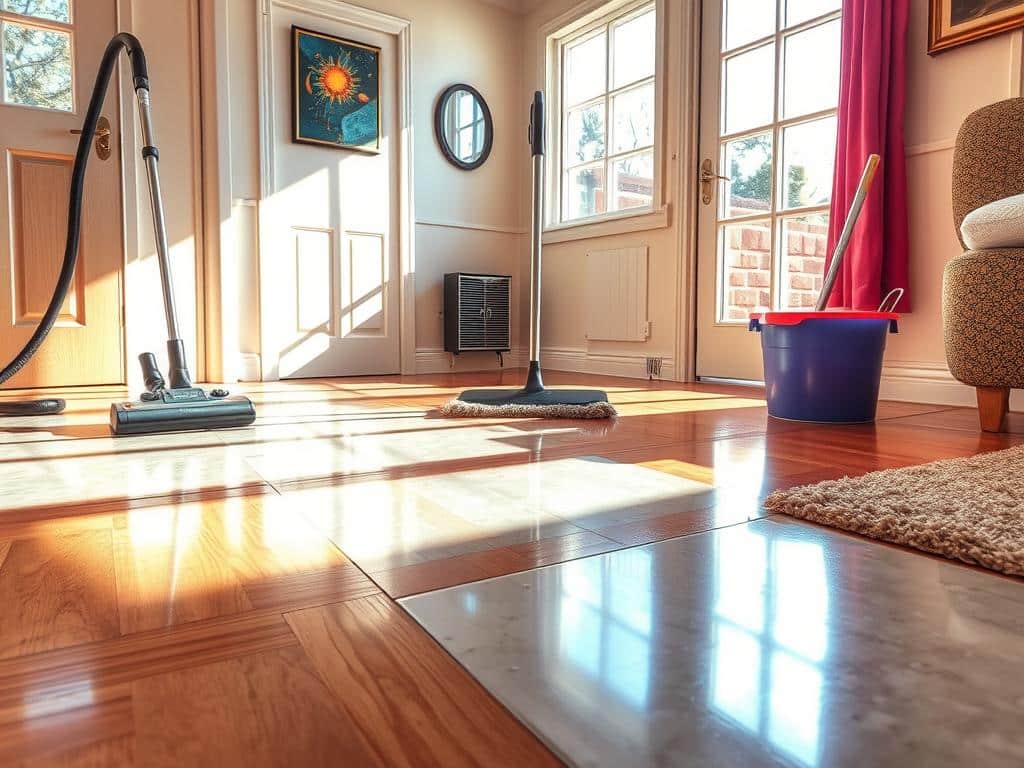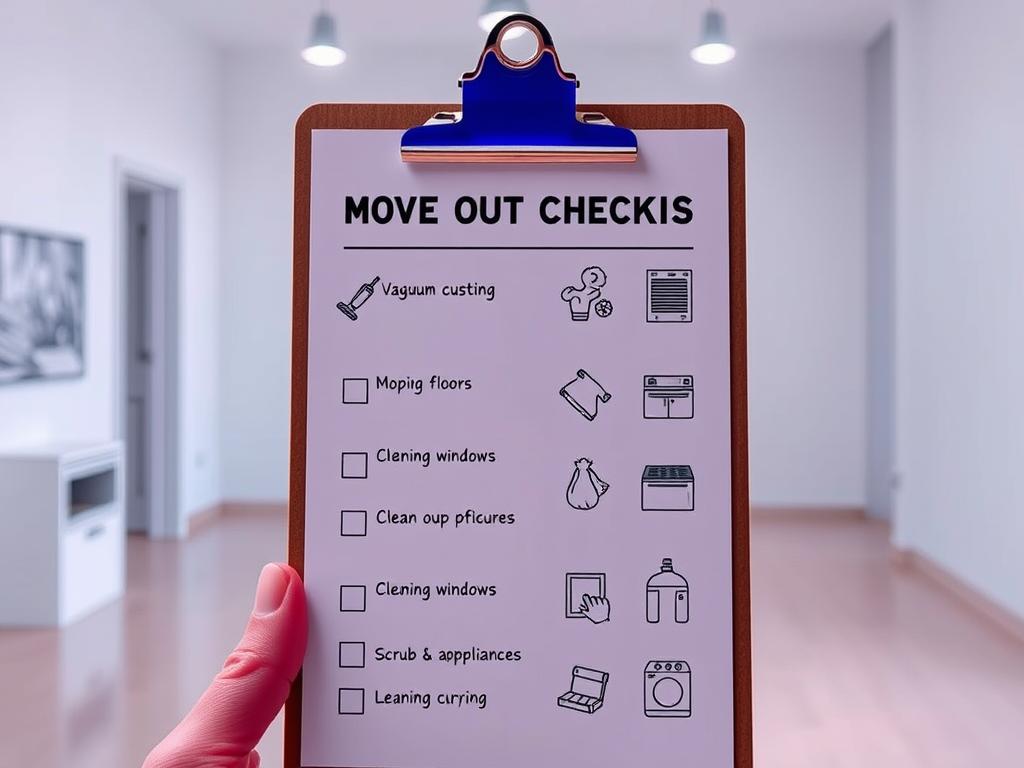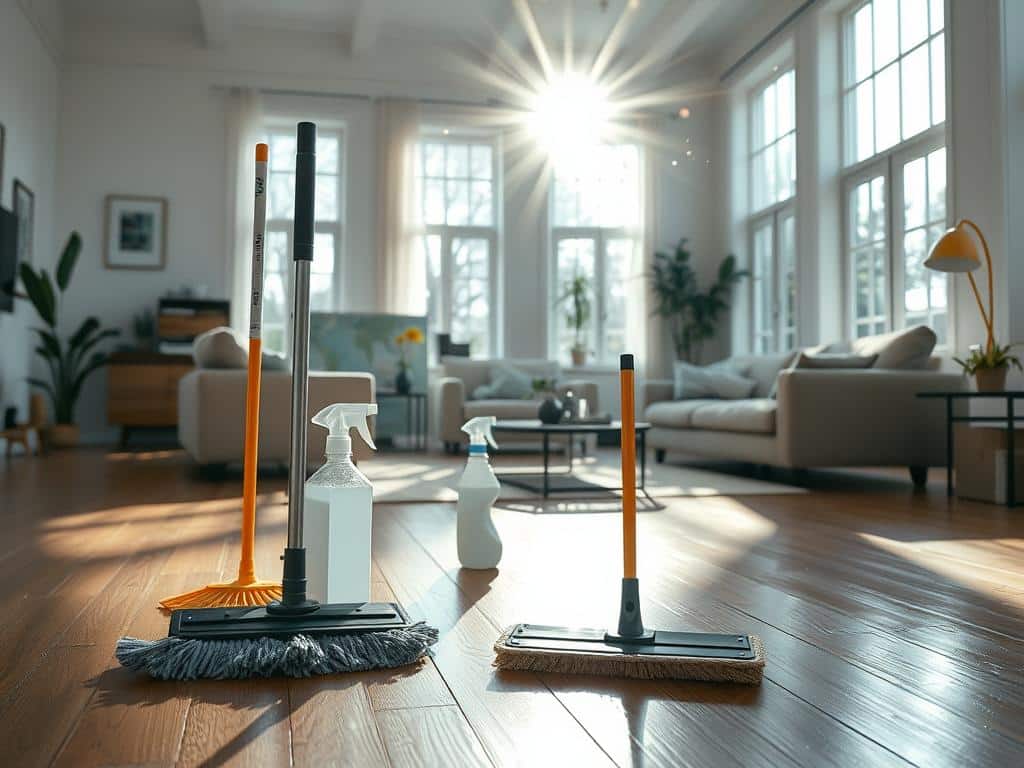
Deep cleaning floors is crucial for keeping them spotless. It goes beyond simple sweeping and mopping. This process is key in homes and businesses to keep floors looking great and lasting longer. Since floors come in materials like hardwood, tile, and vinyl, each needs its own cleaning method. This prevents damage and ensures they’re cleaned well.
For businesses, it’s important to clean floors regularly and quickly take care of any spills. Hardwood floors can be cleaned with a mix of white vinegar and warm water, or a gentle soap for polyurethane finishes. Tile floors do well with grout scrubbing and cleaners made for tile or a vinegar mix. Vinyl and linoleum are also cleaned well with a vinegar solution.
Putting mats at entries can cut down on dirt coming in. This simple step makes a big difference in keeping floors clean. Also, getting help from experts like JAN-PRO Cleaning & Disinfecting can offer top-notch floor cleaning. This is vital for both homes and businesses.
Deep Cleaning Hardwood Floors
Cleaning hardwood floors deeply is key to keeping them looking good and lasting long. By using the right cleaning methods, your floors can stay in top shape for years. Follow this guide for the best results.
Preparation Steps
First, prepare your floor for cleaning. Remove all furniture, rugs, and items from the area. Next, sweep or vacuum the floor well to get rid of dust and debris. This is especially important in areas that get a lot of foot traffic.
Make sure to switch your vacuum to the bare floor setting. This helps avoid scratches and keeps the wood finish looking shiny.
Choosing the Right Cleaner
It’s important to pick a safe cleaner for your hardwood. A mix of white vinegar and warm water (half and half) works well and is safe. Use pH-neutral soaps for a gentle clean on oil-based finishes. Stay away from harsh cleaners that can damage the wood. If you have wax-finished wood, you might need to buff it sometimes.
Cleaning the Floor
Use the right methods to clean your hardwood gently but effectively. A flat mop or microfiber cloth is best for applying cleaner. Make sure the mop is damp, not wet, to prevent water damage. For dirty spots, use a cleaner made for hardwood and a soft, wet mop. Don’t soak the floor, and finish with a damp mop for a shiny look.
Drying the Floor
Drying the floor right is vital to avoid harming it. After cleaning, dry the floor with a clean microfiber cloth or mop. Buff it following the wood grain for a smooth finish. Keeping a spot for wet shoes can also protect the floors from water damage.
Deep clean your hardwood floors once or twice a year. Regular upkeep and spot cleaning keep the wood looking great. Use area rugs in busy spots and furniture pads to avoid daily damage.
Deep Cleaning Tile Floors
Tile floors are both tough and beautiful. Yet, they need regular care to stay shiny. Cleaning them deeply helps them last longer and keeps them sparkling. This includes steps like getting ready, picking the right cleaner, cleaning the grout, and then mopping and drying.
Preparation Steps
Start by sweeping or vacuuming the floor. This gets rid of loose dirt. Having a clean floor means your deep cleaning will work better. Sweep or vacuum at least once a week to help keep the floors clean every day.
Choosing the Right Cleaner
It’s important to choose the right cleaner. An eco-friendly cleaner that makes 16 gallons of solution for $49.00 is a good choice. For cleaning grout, try using white vinegar and warm water. Be sure to avoid harsh chemicals and rough scrubbing tools on your tiles.
Scrubbing Grout Lines
Grout often gets dirty. 70% of people with tile floors face this problem. Scrub grout lines with an old toothbrush or a grout brush that costs $5.00. You can make a natural cleaner with baking soda and water. Then, protect the grout with a silicone-based sealer to keep stains away.
Mopping and Drying
The last steps are to mop and dry your floors. Some prefer a bucket, others a spray bottle. Use a soft mop or microfiber for the cleaning solution. Let the floors wet for 10-15 minutes. Dry them with terry cloth towels to avoid water spots and keep the shine. Marble tiles should be sealed with a protectant each year.
How to Deep Clean Floors: Vinyl and Linoleum
Vinyl and linoleum floors need careful handling to clean well without harm. There are steps to follow to clean these floors without damaging them. Learn how to deep clean them to keep their shine and last longer.
Preparation Steps
Start by picking up any loose dirt. A Hoover ONEPWR Cordless Vacuum or a simple broom works great for this. It’s key in busy spots where dirt piles up fast. Cleaning up dust and dirt first helps avoid scratches and makes the next steps more effective.
Choosing the Right Cleaner
To mix a safe cleaning solution, use one gallon of hot water, one cup of white vinegar, and a bit of Dawn dishwashing liquid. This mix cleans vinyl floors well and is also safe for linoleum. Don’t use rough cleaners or scrub brushes because they scratch. Also, skip shine products to prevent your floor from getting dull.
Cleaning the Floor
Mop with a lightly damp microfiber mop, covering small sections at once. This keeps the mop clean and covers the floor evenly. In high-traffic areas, you might need to mop three times for best results. For tough spots like scuffs or sticky stuff, try Goo-gone, olive oil, or a mix of baking soda and water with a microfiber cloth.
Drying the Floor
To prevent streaks and water damage, dry the floors with clean microfiber cloths after mopping. This step is vital to keep the floors safe. A dry floor keeps its good looks and stays strong and long-lasting. Regular cleaning, like sweeping and mopping every week, can make deep cleans less needed.
Use these steps for your routine of cleaning vinyl and linoleum floors. It will help keep your floors clean and in good shape.
Maintaining Clean Floors
To keep your floors looking great, you need a cleaning routine made for your floor type. Whether you have hardwood, tile, vinyl, or carpet, caring for them regularly keeps them looking new. It also makes them last longer.
Regular Cleaning Routine
A good floor cleaning habit is key. For wood floors, sweep and mop lightly to avoid dirt buildup. Tile floors benefit from regular sweeping or vacuuming. Avoid soap and wax on laminate floors to keep them shiny. Doing this prevents your floors from getting worn out too quickly.
Spot-Cleaning and Immediate Care
Quickly cleaning up spills is vital. Use fast action for spills to stop stains on surfaces like grout. On carpets, treat spots with a good cleaner, then vacuum well. Handling spills fast keeps your floors looking perfect.

Using Floor Mats
Mats are great for floor protection. Place them at doors to catch dirt and water, keeping your house cleaner. This means you’ll need to clean less often. Rubber-backed mats work best in busy spots for more protection.
Keep floors clean with regular cleaning, quick spill cleanups, and using mats. JAN-PRO Cleaning & Disinfecting says these steps, with professional help, lead to the best care.
Conclusion
In wrapping up thoughts on deep cleaning floors, it’s clear a detailed plan is key. Different floors like hardwood, tile, vinyl, or linoleum need their own care methods and cleaners. For hardwood, a mild vinegar mix works well without harming the surface.
Tile floors require scrubbing grout and proper mopping for full cleanliness. For vinyl and linoleum, using the correct cleaner and drying right is critical. It’s important to prevent too much wetness to avoid problems.
This guide highlights how to pick cleaners, clean well, and dry quickly. Deep cleaning is more than just washing floors. It includes everyday dusting and dealing with spills fast. Also, using rugs and furniture pads helps protect floors.
In busy areas, these steps are vital. Although you can clean yourself, professionals offer deep cleaning expertise. They have the tools for tougher jobs. By following these tips, your floors will look great and last longer. Thus, deep cleaning becomes an easy, organized part of taking care of your home.



